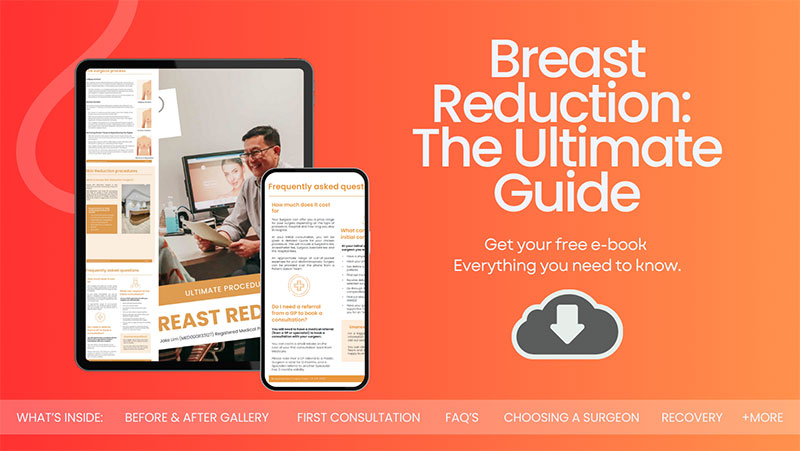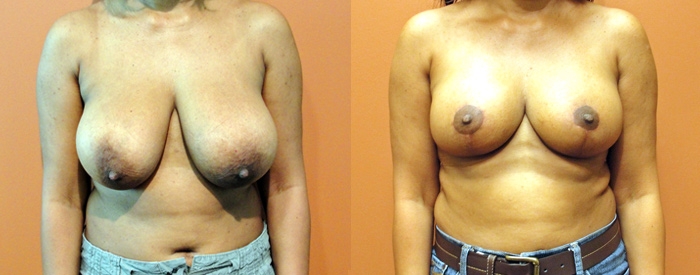Guide to Resuming Exercise after Breast Reduction Surgery
Breast reduction – Reduction Mammoplasty surgery is a procedure that many women opt for, either for medical reasons or personal preferences. While the surgery can bring about benefits, such as relief from back, neck and shoulder pain, it’s essential to approach the post-operative period with care. One of the primary concerns many women have is when and how to return to the gym and exercise after breast reduction. This guide aims to shed light on this topic, ensuring a safe and effective return to physical activity.
Sydney Specialist Plastic Surgeon Dr Jake Lim is a well-regarded plastic surgeon with more than two decades of experience in the field. After graduating from some of the world’s top medical institutions, Dr Lim has dedicated his career to helping patients achieve their desired aesthetic goals while prioritising their health and well-being.
Dr Lim’s 2024 Breast Reduction Guide

Aspects to Consider before Resuming Exercise
Resuming exercise after undergoing breast reduction surgery is a crucial aspect of the post-operative period. Here’s a guide on when and how to reintroduce physical activity:
Listen to Your Body
Every individual’s healing process is unique. While some might feel ready to get back to light activities within a few weeks, others might need more time. It’s essential to listen to your body and not rush the process.
Start with Low-Impact Activities
Once you feel ready, begin with low-impact exercises like walking or stationary cycling. These activities promote blood circulation without putting undue stress on the surgical area.
Avoid High-Impact Activities
Activities that involve jumping, running, or any vigorous movement can cause discomfort and might disrupt the healing process. It’s best to avoid these for a while, even if you feel ready.
Strength Training
When reintroducing strength training, start with lower body exercises first. This allows you to build strength without directly impacting the chest area. As you progress and with Dr Lim’s approval, you can slowly incorporate upper body exercises.
Stretching and Flexibility
Gentle stretching can be beneficial in regaining flexibility and range of motion. Avoid any stretches that pull or strain the chest area.
Hydration and Nutrition
Proper hydration and nutrition play a pivotal role in recovery and energy levels. Ensure you’re consuming a balanced diet and drinking plenty of water to support your exercise routine.
Consult with Your Plastic Surgeon
Always keep an open line of communication with your plastic surgeon. Before reintroducing any form of exercise, seek their advice. Dr Lim can provide specific guidelines based on your individual recovery and healing.
Monitor for Signs of Complications
While exercising, be vigilant for any signs of complications, such as increased swelling, pain, or any unusual changes in the surgical area. If you notice any of these signs, stop exercising immediately and consult your plastic surgeon.
Wear Supportive Clothing
As you resume exercise, wearing supportive clothing, especially a well-fitted sports bra, can provide comfort and support, reducing any potential strain on the surgical area.
Progress Gradually
As with any exercise regimen, it’s essential to progress gradually. Increase the intensity and duration of your workouts slowly to ensure you’re not overexerting yourself.
Reintroducing exercise after breast reduction surgery requires patience, caution, and guidance. By following the above steps and always consulting with Dr Lim, you can ensure a safe and effective return to your fitness routine.

Recommended Exercises after Breast Reduction Surgery
Here’s a guide to some gentle exercises to help you on your road to recovery:
Deep Breathing Exercises:
- Start by taking a deep breath in through your nose, filling your lungs completely
- Hold for a few seconds and then exhale slowly through your mouth
- This can help improve lung function and oxygenate your blood, aiding in the healing process
Ankle Circles:
- While sitting or lying down, rotate your ankles in a circular motion
- This can help prevent blood clots in the legs, especially if you’re not moving around much
Leg Lifts:
- Lying on your back, lift one leg at a time, keeping the other leg straight on the bed or floor
- This strengthens your leg muscles without putting strain on your chest
Arm Stretches:
- With your arms by your side, slowly lift them up and out to the side, but not above shoulder height
- Hold for a few seconds and then lower them slowly
- This can help maintain flexibility in the arms without stressing the surgery site
Neck Tilts:
- Gently tilt your head from side to side and forward and backward
- This can help relieve tension in the neck area
Walking:
- Start with short, slow walks around your home
- Gradually increase the distance as you feel comfortable, but avoid any strenuous activity or brisk walking
Tips to Resume Exercise after Breast Reduction Surgery
- Always wear your post-surgical bra or any support garment recommended by your plastic surgeon during exercises
- Avoid lifting heavy objects or any exercises that involve bending over
- Listen to your body. If you feel any pain or discomfort, stop immediately and consult Dr Lim
- Remember to check in with Dr Lim before starting any new exercises
What NOT to Do Regarding Exercise after Breast Reduction Surgery
Here’s a list of things you should avoid in terms of exercise after undergoing breast reduction surgery:
- High-Impact Activities: Avoid running, jumping, or any other high-impact exercises that can cause excessive movement or bouncing of the breasts. These can disrupt the healing process and cause complications
- Heavy Lifting: Do not lift anything heavy, including weights, groceries, or even small children. Lifting can strain your incisions and potentially lead to complications
- Strenuous Upper Body Workouts: Exercises like push-ups, pull-ups, or heavy weight lifting that target the chest or upper body should be avoided. These can put undue stress on the surgical site
- Stretching or Reaching Overhead: Avoid activities that require you to stretch or reach overhead, such as putting items on a high shelf. This can pull on the incisions and disrupt the healing process
- Swimming or Immersing in Water: Do not swim or immerse your body in water, including baths, hot tubs, or swimming pools, until your plastic surgeon gives the all-clear. Water can introduce bacteria to the incision sites, increasing the risk of infection
- Engaging in Sports: Refrain from playing sports, especially those that involve physical contact or the risk of being hit in the chest area
- Yoga or Pilates: While these might seem gentle, certain poses can stretch or put pressure on the chest area. It’s best to wait until you’re fully healed before resuming these activities
- Abdominal Exercises: Avoid exercises that engage the core too intensely, such as sit-ups or crunches, as they can put pressure on the chest area
- Ignoring Pain: If any exercise or movement causes pain, stop immediately. Pain is your body’s way of telling you something isn’t right
- Resuming Exercise Too Soon: Even if you feel good, don’t rush back into your regular exercise routine. Always consult with Dr Lim about when it’s safe to start exercising again and at what intensity.
Choosing Sports Clothing for Exercise after Breast Reduction Surgery
Choosing the right sports clothing after breast reduction surgery is crucial to ensure comfort, support, and proper healing. Here’s a guide on how to select the best attire:
Post-Surgical Sports Bra:
- Support: Opt for a sports bra that offers firm support without being too tight. It should hold the breasts securely without causing any discomfort
- Front Closure: Bras with front closures are easier to put on and take off without straining the surgical site
- Wide Straps: These distribute weight evenly, reducing pressure on the shoulders
- Breathable Material: Fabrics like cotton or moisture-wicking materials can help prevent sweat build up, reducing the risk of infections
- No Underwire: Until Dr Lim gives the all-clear, avoid bras with underwires as they can irritate the incisions
Tops:
- Soft and Stretchy: Choose tops made of soft, stretchy materials that are easy to put on and remove without causing discomfort
- Loose-fitting: Initially, you might prefer looser tops that don’t rub against or put pressure on the surgical site
- Moisture-Wicking: This helps to draw sweat away from the body, keeping you dry and comfortable
Bottoms:
- High-Waisted: High-waisted leggings or shorts can offer support to the abdominal area, which might be tender post-surgery
- Elastic Waistband: Ensure the waistband isn’t too tight, as you don’t want any clothing pressing too hard against your body
- Breathable Material: Like tops, opt for materials that allow your skin to breathe and wick away moisture
Footwear:
- Supportive Shoes: Especially if you’re walking as part of your post-surgery exercise, choose shoes that offer good arch support and cushioning
- Easy to Wear: Consider shoes that are easy to slip on and off to avoid bending and straining
FAQ’s about Breast Reduction Surgery and Recovery

Q. When can I start exercising after breast reduction surgery?
Typically, light activities like walking can be resumed within a few days post-surgery. However, more strenuous exercises, especially those involving the upper body, should be avoided for at least 4-6 weeks. Consult with Dr Lim before resuming any form of exercise.
Q. Why is it important to avoid certain exercises after surgery?
Engaging in high-impact or strenuous exercises too soon can put undue stress on the surgical site, potentially leading to complications such as increased swelling, bleeding, or disruption of the healing process. It’s essential to give your body the time it needs to heal properly.
Q. What type of sports bra should I wear during my recovery?
Opt for a post-surgical or supportive sports bra without underwires. It should offer firm support without being too tight and preferably have front closures for ease of use. Breathable materials and wide straps are also beneficial. Your plastic surgeon may have specific recommendations based on your individual needs.
Q. How will I know if I’m overexerting myself during exercise?
Listen to your body. If you experience pain, increased swelling, or any unusual discomfort, it’s a sign that you might be overdoing it. It’s essential to start slow and gradually increase the intensity of your workouts as your body heals.
Q. Can exercise affect the final results of my breast reduction?
Yes, engaging in strenuous activities too soon can impact the final results of your surgery. It can lead to increased scarring, bleeding, asymmetry, or other complications. Following your plastic surgeon’s guidelines regarding exercise can help ensure optimal results.
Q. When can I return to high-impact activities like running or jumping?
Dr Lim recommends waiting at least 6-8 weeks before resuming high-impact activities. However, this can vary based on individual healing progress. Always get a clearance from your plastic surgeon before returning to such exercises.
Further Reading about Breast Surgery with Dr Jake Lim
- Read Dr Lim’s Breast Reduction Surgery Page
- Read Dr Lim’s Blog about Compression Bras after Breast Reduction Surgery
- Read Dr Lim’s Blog about Does Medicare Cover Breast Reduction Surgery?
- Read Dr Lim’s Nipple Reduction Surgery Page
- Read Dr Lim’s Post Pregnancy Procedures Page
- Read Dr Lim’s Efficient Methods to Reduce Bruising after Breast Reduction Surgery
- Read Dr Lim’s How to Prepare for Your Breast Reduction Surgery
- Read Dr Lim’s Breast Reduction FAQs
Medical References about Breast Reduction Surgery and Recovery
- Breast reduction surgery – Mayo Clinic
- Breast Reduction – ASPS
- Breast reduction – NHS




